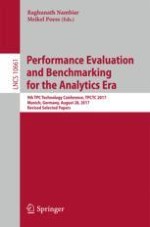2018 | Book
Performance Evaluation and Benchmarking for the Analytics Era
9th TPC Technology Conference, TPCTC 2017, Munich, Germany, August 28, 2017, Revised Selected Papers
Editors: Raghunath Nambiar, Meikel Poess
Publisher: Springer International Publishing
Book Series : Lecture Notes in Computer Science
